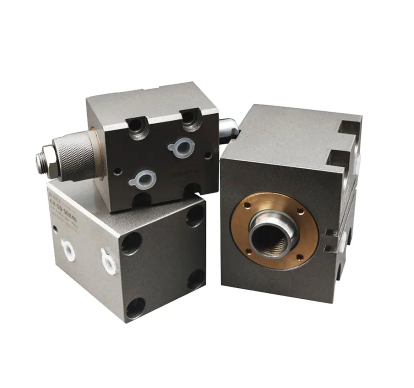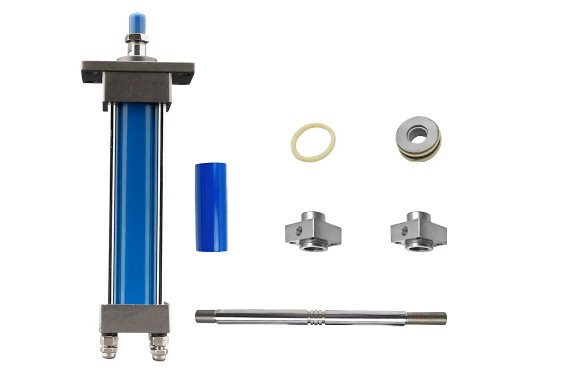Hydraulic systems are the backbone of modern machinery, converting fluid pressure into powerful, controlled linear motion. At the heart of these systems, hydraulic cylinders act like the muscles, driving movement with precision and force. Controlling a hydraulic cylinder means managing its speed, direction, force, and position, ensuring that every motion is smooth, efficient, and safe. Just like a well-regulated ecosystem in nature, where every element interacts precisely to maintain balance, a properly controlled hydraulic system achieves harmony between power, efficiency, and reliability. Understanding how to control cylinders is essential for engineers, operators, and anyone working with fluid power technology.
How Hydraulic Cylinders Work
Hydraulic cylinders are linear actuators. Fluid pressure moves a piston, which pushes a rod. The rod’s motion depends on which side of the piston receives pressurized fluid. Fluid on the opposite side returns to the reservoir. The cylinder is sealed to prevent leaks and protect the hydraulic system.
Key Cylinder Components
| Part | Function |
| Cylinder barrel | Holds pressure and guides piston |
| Piston | Transfers force and separates pressure zones |
| Piston rod | Connects piston to the load |
| Cylinder head/cap | Closes ends and houses seals |
| Seals | Prevent leaks and contamination |
| Mounts | Secure cylinder to machinery |
Why Control of Hydraulic Cylinders Matters
Control of a hydraulic cylinder is essential for the safe and efficient operation of any hydraulic system. It determines how fast the piston moves, how much force is applied, the direction of motion, and the precise position at which the cylinder stops. Without proper control, the cylinder can extend or retract too quickly, generate excessive force that may damage the machinery, or behave unpredictably, which can compromise both safety and performance. Effective control reduces wear on components, minimizes maintenance needs, and ensures smooth operation under varying loads and pressures.
Main Parameters Controlled
Speed: This refers to how fast the piston moves during extension or retraction. Speed is controlled by regulating the hydraulic fluid flow. Precise speed control is crucial in applications like lifting heavy loads or positioning tools accurately.
Force: The push or pull strength of a cylinder depends on the pressure of the hydraulic fluid and the surface area of the piston. Controlling force prevents overloading the system, protects mechanical parts, and ensures safe handling of materials.
Direction: Proper control allows the piston to move in the intended direction—extending or retracting. Direction control is important when cylinders perform repetitive tasks, such as in construction machinery or industrial presses.
Position: Controlling the exact stopping point of the piston ensures precision in operations. Position control is often used in robotics, assembly lines, and automated machinery where accuracy is critical. Sensors or electronic feedback systems can improve position monitoring and reduce human error.
By managing these parameters, operators can make hydraulic cylinders work safely, efficiently, and consistently, even under complex or heavy-duty conditions.

Types of Hydraulic Cylinders and Control Considerations
Single-Acting Cylinders
Single-acting cylinders operate in only one direction. The return stroke is achieved by a spring, gravity, or an external mechanical force. They are simple in design, cost-effective, and suitable for tasks like tilting, lifting, or pushing light loads. Because fluid acts on only one side of the piston, controlling speed and force is straightforward, but precision is limited compared to double-acting cylinders. These cylinders are commonly used in agricultural machinery, small presses, and safety mechanisms where motion only needs to occur in a single direction.
Double-Acting Cylinders
Double-acting cylinders receive hydraulic fluid on both sides of the piston, enabling motion in both directions. The force generated during extension is generally higher than during retraction because the rod reduces the effective piston area on the return side. They are widely used in industrial presses, mobile machinery, and material handling equipment. Controlling speed, force, and direction in double-acting cylinders requires careful valve selection, flow management, and sometimes feedback sensors to maintain consistent performance under varying loads.
Telescopic Cylinders
Telescopic cylinders consist of multiple nested pistons that extend sequentially, allowing very long strokes from a compact cylinder body. These are commonly used in cranes, dump trucks, and applications where installation space is limited. Synchronized telescopic designs connect the stages internally to ensure all pistons move simultaneously at a nearly constant speed. Because each stage has a different piston area, precise control of hydraulic flow and pressure is crucial to prevent stage binding, uneven extension, or shock loading.
Differential and Regenerative Cylinders
Differential or regenerative cylinders redirect fluid from the rod side back to the cap side to increase extension speed. This technique allows faster movement without increasing pump output, improving efficiency in large-stroke applications. However, it introduces higher pressure on certain parts of the cylinder, requiring careful control and proper relief valves to prevent overload or damage. These cylinders are often found in construction equipment, industrial presses, and applications where speed and force must be balanced for efficiency and safety.
| Cylinder Type | Operation | Control Considerations | Common Applications |
| Single-Acting Cylinders | Operates in one direction; return by spring, gravity, or external force | Simple speed and force control; limited precision compared to double-acting | Agricultural machinery, small presses, safety mechanisms |
| Double-Acting Cylinders | Fluid acts on both sides of piston for bidirectional motion | Requires careful valve selection, flow management, and sometimes sensors for consistent performance | Industrial presses, mobile machinery, material handling |
| Telescopic Cylinders | Multiple nested pistons extend sequentially | Precise flow and pressure control to prevent stage binding or uneven extension | Cranes, dump trucks, space-limited machinery |
| Differential / Regenerative Cylinders | Rod-side fluid redirected to cap side for faster extension | Must manage higher pressure on certain cylinder parts; relief valves needed | Construction equipment, industrial presses, long-stroke applications |
Methods to Control Hydraulic Cylinder Speed
1. Metered Flow Control
Metered flow control limits the amount of hydraulic fluid entering the cylinder, directly controlling piston speed. Reverse flow check valves allow fluid to return freely during retraction, preventing pressure buildup. This method is widely used in industrial hydraulic systems because it provides smooth, predictable motion and can handle moderate to high loads. Adjusting the valve can fine-tune the cylinder speed without affecting overall system pressure, making it simple yet reliable for many applications.
2. Non-Metered Flow Control
Non-metered flow control regulates the speed by restricting fluid leaving the cylinder rather than entering it. It can improve energy efficiency during slow, gravity-driven movements because the fluid does not need to be pumped against high pressure. However, if applied incorrectly, it may cause pressure spikes on the rod side, increasing the risk of leaks or mechanical failure. This method is best used for controlled descent of loads or in low-speed, low-precision operations.
3. Needle Valves
Needle valves restrict hydraulic flow in both directions, providing fine adjustment for cylinder speed. They are cost-effective, compact, and ideal for low-speed applications where precise motion control is needed. Incorporating check valves prevents reverse flow, protecting the cylinder and other components in the hydraulic system. They are commonly used in small presses, testing equipment, and other applications where gradual movement is critical.
4. 3-Port Priority Flow Control
3-port priority flow control valves split the incoming hydraulic flow between two outputs. The priority port ensures that the main cylinder receives fluid first, maintaining essential operations. Built-in relief valves prevent overpressure, protecting both the cylinder and the system. These valves are ideal for multi-actuator setups, though excess flow that is not used by the actuators may dissipate as heat. They provide stable performance but require careful sizing and adjustment to avoid energy loss.
5. Proportional Directional Valves
Proportional directional valves use electronic signals to move the spool proportionally, regulating flow with high precision. They allow smooth acceleration and deceleration of the cylinder, automatically adjusting to load variations. These valves are essential in automation, robotics, and industrial machinery where precise control of speed and position is critical. By integrating sensors and feedback, proportional valves can optimize performance, reduce energy waste, and extend the life of both the cylinder and the hydraulic system.
Controlling Force in Hydraulic Cylinders
The force a hydraulic cylinder can generate depends on the piston area and the hydraulic fluid pressure applied. In single-rod cylinders, the retraction force is often less than the extension force because the piston rod occupies some area on the rod side. Double-rod cylinders balance forces on both sides, providing nearly equal push and pull capability.
Force control techniques include:
Pressure relief valves – Limit maximum force to protect the cylinder and system from overload.
Load-sensing valves – Automatically adjust flow and pressure based on the load, improving efficiency and safety.
Regenerative circuits – Redirect fluid to increase piston speed without reducing available force, enhancing productivity in large-stroke applications.
Careful force control ensures smooth operation, reduces wear, and prevents accidents in industrial and mobile hydraulic systems.

Controlling Cylinder Position
Position Sensing
Position sensing allows the system to know the exact location of the piston inside the cylinder. This is typically achieved with magnets embedded in the piston and sensors using Hall Effect or similar technology. This method avoids the need for hollow rods and provides precise control of extension and retraction.
Smart Hydraulic Cylinders
Smart hydraulic cylinders integrate sensors, controllers, or PLCs to monitor speed, force, and position in real time. They are ideal for automated industrial systems, material handling, and robotics. By collecting data on motion and load, these cylinders help optimize performance, improve efficiency, and predict maintenance needs, reducing downtime and extending equipment life.
FAQ
What is hydraulic cylinder control?
Hydraulic cylinder control refers to managing the speed, force, direction, and position of a cylinder to ensure safe and efficient operation within a hydraulic system.
Why is controlling cylinder speed important?
Controlling speed prevents abrupt movements, protects machinery from damage, and ensures smooth operation, especially in precise or heavy-load applications.
How can I control the force of a hydraulic cylinder?
Force can be controlled using pressure relief valves, load-sensing valves, or regenerative circuits to maintain safe and consistent performance.
What is the difference between single-acting and double-acting cylinders?
Single-acting cylinders move in one direction and return via spring, gravity, or external force, while double-acting cylinders use hydraulic fluid on both sides for bidirectional motion.
Conclusion
Mastering hydraulic cylinder control ensures that hydraulic systems operate safely, efficiently, and predictably, whether in industrial presses, mobile machinery, or automated equipment. From regulating speed with flow control to monitoring position with sensors, each method contributes to a reliable and durable system.
For businesses seeking high-quality, precision hydraulic solutions, Dongguan Blince Machinery & Electronics Co., Ltd. offers advanced products and expert support to optimize performance in any application, helping machinery run smarter and longer.




















